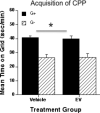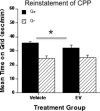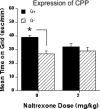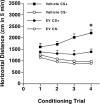Involvement of the beta-endorphin neurons of the hypothalamic arcuate nucleus in ethanol-induced place preference conditioning in mice
- PMID: 22014186
- PMCID: PMC4151392
- DOI: 10.1111/j.1530-0277.2011.01553.x
Involvement of the beta-endorphin neurons of the hypothalamic arcuate nucleus in ethanol-induced place preference conditioning in mice
Abstract
Background: Increasing evidence indicates that mu- and delta-opioid receptors are decisively involved in the retrieval of memories underlying conditioned effects of ethanol. The precise mechanism by which these receptors participate in such effects remains unclear. Given the important role of the proopiomelanocortin (POMc)-derived opioid peptide beta-endorphin, an endogenous mu- and delta-opioid receptor agonist, in some of the behavioral effects of ethanol, we hypothesized that beta-endorphin would also be involved in ethanol conditioning.
Methods: In this study, we treated female Swiss mice with estradiol valerate (EV), which induces a neurotoxic lesion of the beta-endorphin neurons of the hypothalamic arcuate nucleus (ArcN). These mice were compared to saline-treated controls to investigate the role of beta-endorphin in the acquisition, extinction, and reinstatement of ethanol (0 or 2 g/kg; intraperitoneally)-induced conditioned place preference (CPP).
Results: Immunohistochemical analyses confirmed a decreased number of POMc-containing neurons of the ArcN with EV treatment. EV did not affect the acquisition or reinstatement of ethanol-induced CPP, but facilitated its extinction. Behavioral sensitization to ethanol, seen during the conditioning days, was not present in EV-treated animals.
Conclusions: The present data suggest that ArcN beta-endorphins are involved in the retrieval of conditioned memories of ethanol and are implicated in the processes that underlie extinction of ethanol-cue associations. Results also reveal a dissociated neurobiology supporting behavioral sensitization to ethanol and its conditioning properties, as a beta-endorphin deficit affected sensitization to ethanol, while leaving acquisition and reinstatement of ethanol-induced CPP unaffected.
Copyright © 2011 by the Research Society on Alcoholism.
Figures






Similar articles
-
The role of endogenous beta-endorphin and enkephalins in ethanol reward.Neuropharmacology. 2013 Oct;73:290-300. doi: 10.1016/j.neuropharm.2013.06.001. Epub 2013 Jun 14. Neuropharmacology. 2013. PMID: 23770261 Free PMC article.
-
Monosodium glutamate-induced reductions in hypothalamic beta-endorphin content result in mu-opioid receptor upregulation in the medial preoptic area.Neuroendocrinology. 1992 Sep;56(3):378-84. doi: 10.1159/000126252. Neuroendocrinology. 1992. PMID: 1331839
-
Ethanol injected into the hypothalamic arcuate nucleus induces behavioral stimulation in rats: an effect prevented by catalase inhibition and naltrexone.Behav Pharmacol. 2008 Oct;19(7):698-705. doi: 10.1097/FBP.0b013e328315ecd7. Behav Pharmacol. 2008. PMID: 18797246
-
Orphanin FQ-ORL-1 regulation of reproduction and reproductive behavior in the female.Vitam Horm. 2015;97:187-221. doi: 10.1016/bs.vh.2014.11.002. Epub 2015 Jan 14. Vitam Horm. 2015. PMID: 25677773 Review.
-
Estrogen-induced hypothalamic beta-endorphin neuron loss: a possible model of hypothalamic aging.Exp Gerontol. 1995 May-Aug;30(3-4):253-67. doi: 10.1016/0531-5565(94)00040-a. Exp Gerontol. 1995. PMID: 7556506 Review.
Cited by
-
Acquisition and reconditioning of ethanol-induced conditioned place preference in mice is blocked by the H₂O₂ scavenger alpha lipoic acid.Psychopharmacology (Berl). 2013 Apr;226(4):673-85. doi: 10.1007/s00213-012-2831-9. Epub 2012 Aug 11. Psychopharmacology (Berl). 2013. PMID: 22885873
-
Morphine and ethanol pretreatment effects on expression and extinction of ethanol-induced conditioned place preference and aversion in mice.Psychopharmacology (Berl). 2021 Jan;238(1):55-66. doi: 10.1007/s00213-020-05658-x. Epub 2020 Sep 26. Psychopharmacology (Berl). 2021. PMID: 32980910 Free PMC article.
-
The influence of drug class on reward in substance use disorders.Pharmacol Biochem Behav. 2024 Jul;240:173771. doi: 10.1016/j.pbb.2024.173771. Epub 2024 Apr 24. Pharmacol Biochem Behav. 2024. PMID: 38670466 Free PMC article. Review.
-
Modulation of ethanol-induced conditioned place preference in mice by 3-amino-1,2,4-triazole and D-penicillamine depends on ethanol dose and number of conditioning trials.Psychopharmacology (Berl). 2013 Dec;230(4):557-68. doi: 10.1007/s00213-013-3177-7. Epub 2013 Jul 7. Psychopharmacology (Berl). 2013. PMID: 23832421
-
Naloxone effects on extinction of ethanol- and cocaine-induced conditioned place preference in mice.Psychopharmacology (Berl). 2017 Sep;234(18):2747-2759. doi: 10.1007/s00213-017-4672-z. Epub 2017 Jun 26. Psychopharmacology (Berl). 2017. PMID: 28653079 Free PMC article.
References
-
- Allen SA, Grisel JE. Absence of EtOH-induced sensitization in b-endorphin deficient mice. Alcoholism: Clinical and Experimental Research. 2005;29:P824.
-
- Angelogianni P, Gianoulakis C. Prenatal exposure to ethanol alters the ontogeny of the beta-endorphin response to stress. Alcoholism: Clinical and Experimental Research. 1989;13:564–571. - PubMed
-
- Bahar A, Samuel A, Hazvi S, Dudai Y. The amygdalar circuit that acquires taste aversion memory differs from the circuit that extinguishes it. European Journal of Neuroscience. 2003;17:1527–1530. - PubMed
-
- Bardo MT, Bevins RA. Conditioned place preference: what does it add to our preclinical understanding of drug reward? Psychopharmacology. 2000;153:31–43. - PubMed
-
- Barros DM, Izquierdo LA, Medina JH, Izquierdo I. Pharmacological findings contribute to the understanding of the main physiological mechanisms of memory retrieval. Current Drug Targets CNS and Neurological Disorders. 2003;2:81–94. - PubMed
Publication types
MeSH terms
Substances
Grants and funding
LinkOut - more resources
Full Text Sources
Research Materials
Miscellaneous

